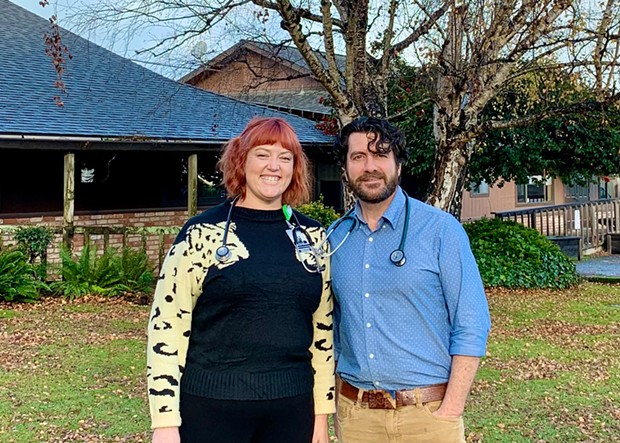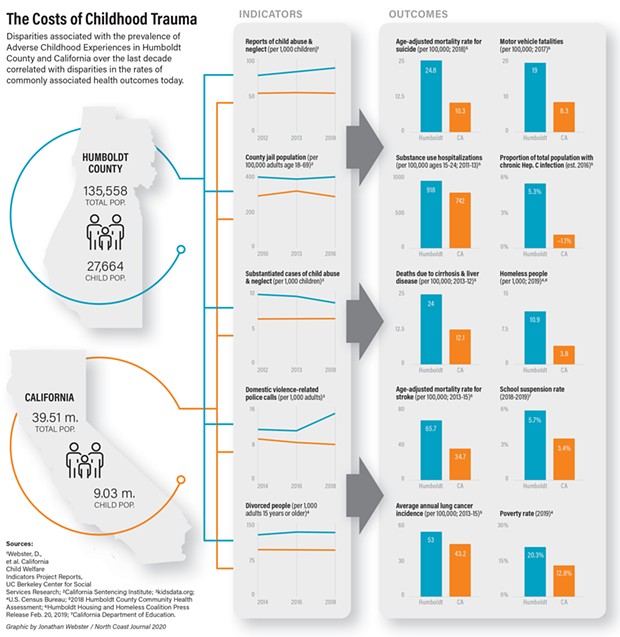'A Paradigm Shift'
Local physicians screening for ACEs have seen an adjustment in pediatric care.
By Iridian Casarez [email protected][
{
"name": "Top Stories Video Pair",
"insertPoint": "7",
"component": "17087298",
"parentWrapperClass": "fdn-ads-inline-content-block",
"requiredCountToDisplay": "1"
}
]
Within the past year Mike Mangahas, a pediatrician at Open Door Community Health Clinic in Eureka, has seldom prescribed medications to patients with serious behavioral issues. Instead, he's using information from a survey about patients' childhood traumas — known as adverse childhood experiences, or ACEs — to inform a more holistic model of care.
"I have been prescribing a lot less psychotropic medications and it's been easier to tease out, for example, if I should start a kid on ADHD medication or not," Mangahas said. "So, if a kid screens positive for ACEs and behavioral health concerns, I'll be very conservative and work on supporting exercise and nutrition and relationships and kind of all the stress-busting stuff that [California Surgeon General] Nadine Burke Harris talked about in her report first, and if that's not working or there's significant impairment at home or school, then that's when I start medication. For me, it's made it a lot easier for me to feel comfortable not jumping to meds."
Over at Redwood Pediatrics in Fortuna, pediatrician Evan Buxbaum and his team are doing the same, taking a more holistic approach with an understanding of the underlying causes of many medical conditions.
"We all have these kids in our practices that come in with one complaint or another and you can give antibiotics for an ear infection, or a sinus infection, or pneumonia, or you can try to address chronic aches and pains, but understanding the root cause of those symptoms and being able to address the toxic stress in the child's life is a paradigm shift in pediatrics and allows us to start to address the whole child in a way that simply treating symptoms doesn't," Buxbaum said.
Over the past five years, there has been a shift in pediatrics as providers increasingly understand how both childhood trauma and toxic stress affect child development ("Reaching for Resilience," Oct. 1, 2020). Systems and practices are changing to be more empathetic and understanding, as the state Surgeon General's Office is working to reduce extreme levels of toxic stress, urging doctors and providers to find patients who may be at risk of toxic stress by determining what childhood traumas they've experienced.
"In pediatrics, we are concerned with developmental milestones and the factors in a child's life that affect their development and growth," Buxbaum said. "I think that I, like a lot of people, was introduced to [the initial] study and to the profound influence that ACEs have on child development through the work of Nadine Burke Harris. We all had that moment of recognition that we were under-emphasizing adverse childhood experiences in the consideration of childhood wellness and diseases."
The U.S. Centers for Disease Control and Kaiser Permanente quantify "adverse childhood experiences" with 10 different categories of stressful traumatic experiences including: experiencing sexual, emotional and physical abuse, or emotional or physical neglect; living in a household with someone who suffers from mental illness, domestic violence, substance abuse or divorce, or having an incarcerated relative. Each experience is called an "ACE," with the cumulative total known as a person's ACEs score on a scale of one to 10. If children experience more than one ACE, they could be at increased risk of toxic stress.
As both physicians referenced, Harris has dedicated her career to learning exactly how childhood trauma and stress affect children's growth, and how to help families avoid and reduce stress.
Through the Center for Youth Wellness in 2014, she found that when children are exposed to various stressful situations, their bodies create an overwhelming amount of cortisol, the body's stress hormone, putting them in a constant fight or flight mental state, which has been linked to higher rates of unhealthy conditions in adulthood, like heart disease, diabetes and substance abuse, among others, which are now known as "ACE-associated health conditions."
The CYW report found that Humboldt and Mendocino counties combined have the highest rate of childhood trauma in California, with roughly 75 percent of residents having experienced one or more ACEs and 30 percent having experienced four or more.
Harris found the best way to overcome toxic stress is to first teach children and adults the coping skills needed to manage stress in healthy ways, like forming and maintaining relationships, exercising and eating well. She also noted another way to help reduce stress in families would be to provide them with needed social services, like access to food, secure housing, parenting classes, counseling and more.
Since the release of the CYW report, Humboldt County has been working to reduce its high rates of childhood trauma. School systems are enacting more empathetic approaches to discipline, while other organizations are creating more resources for families and kids in need, like the Humboldt Independent Practice Association's School Based Health Center in McKinleyville, which offers group counseling and mentors for its students.
One of the best ways to create a trauma-informed practice that treats the underlying problems that can lead to poor health in adulthood is to directly ask children what they've experienced using a survey.
In December of 2019, the California Surgeon General Office's ACEs Aware Initiative created a training program to certify providers to ask their patients about childhood trauma. As an incentive, the state is reimbursing providers with a $29 payment for conducting the surveys of all patients with full-scope Medi-Cal.
The initiative has trained more than 20,500 California clinicians, including roughly 65 Humboldt County providers, 16 of whom have become certified and can receive reimbursements for ACE screenings, including Buxbaum and Mangahas.
Both said the screenings have made a huge difference.
"Once we started to recognize the degree to which adverse childhood experiences affect growth and development, performance in school, frequency of illness, ability to bounce back from illness and overall well-being, we recognized the importance of identifying and following, over time, these ACE scores," Buxbaum said. "It has dramatically affected our practice. It has dramatically improved our practice in that at every visit we have the opportunity to address those root causes that prevent children from thriving."
Both physicians use the state's survey, known as the Pediatrics ACEs and Related Life-events Screener (PEARLS), to ask patients about the stressful situations they've been in. It asks about all 10 of the adverse childhood experiences, as well as related life events, like experiencing discrimination or food and housing insecurity.
When a patient and their parents visit Redwood Pediatrics, they are now asked to fill out the PEARLS survey, with questions like: "Has your child ever lived with a parent/caregiver who went to jail/prison?"; "Has a parent/caregiver ever insulted, humiliated or put down your child?"; "Has your child ever seen or heard a parent/caregiver being screamed at, sworn at, insulted or humiliated by another adult? Or has your child ever seen or heard a parent/caregiver being slapped, kicked, punched, beaten up or hurt with a weapon?"
Buxbaum said he rarely receives negative reactions from parents and caregivers when he asks them about these traumas.
"We thought we were going to experience a lot of pushbacks," he said. "These are very personal questions, and they speak to the deepest traumas in families — sometimes the traumas that people don't even talk about among themselves. But it's been surprisingly rare that people have been unwilling to talk about these questions. ... Most parents open up and are really very willing to discuss the issues that come up. It's been rare that people push back and don't want to be vulnerable."
Instead, Buxbaum said, it initiates important conversations.
They discuss the impact these experiences have on children, the science of toxic stress and what it does to growth and development. Then they address which traumatic experiences the child has been exposed to and, if the trauma or life event calls for a referral to any outside organization, Redwood Pediatrics' referral coordinator works with families to get the needed services.
For example, if a child comes to Buxbaum with belly pain and his office has ruled out all medical health conditions causing it, they will check the child's medical chart and PEARLS survey to determine how much trauma they've experienced. If they find the child has an ACEs score higher than four, that belly pain is probably stemming from stress. The next step would be to help the child navigate and cope with the stress they are experiencing.
Buxbaum said the survey has also given his teenage patients the opportunity to talk about the emotional and mental health challenges, like depression and anxiety, they may be facing, adding that when it's appropriate, his office refers patients to therapists or other mental health professionals.
For now, at Open Door, Mangahas is only screening children 4 years old and younger, expecting and new mothers and children with behavioral issues. He has the same process as Buxbaum, using the PEARLS survey and then discussing why his office is asking about these experiences, their effects and the different coping strategies to combat stress.
For example, if one of Mangahas' patients is having trouble sleeping, he talks to the parents about how stress can change sleep patterns in children and then gives different tips and tricks to help them sleep better.
Mangahas said he has noticed that the kids who come into his office with behavioral issues are more likely to have higher rates of childhood trauma and have an ACE score of four or more, usually in the eight to nine range. In the patients younger than 4 years old, roughly 15 percent have a score of four or more ACEs, while about 30 percent have a score of one or more ACE, he said.
Even though this data is extremely limited and anecdotal in nature, it is still significant, underscoring what the CYW 2014 study found: Humboldt County kids have higher rates of exposure to trauma. However, Buxbaum noted he's seeing a lot of anxiety and depression, even in patients with low rates of childhood trauma.
Buxbaum said the survey results are private and stay in patients' medical charts, adding the only data that's sent to the state simply indicates when an ACEs screening is performed.
The most important part of asking patients about childhood trauma is what comes after: referrals to the proper services, whether that's teaching children coping skills, a behavioral therapist, parenting classes at a family resource center, sibling support groups or a food pantry. However, Mangahas said these referrals are almost impossible to do without a system connecting all the various local organizations.
The state has long advocated for referring patients to outside organizations for whatever they need but more recently has outlined what providers can do to make that part of the process more streamlined.
In June, the state released a report exploring the idea of creating a robust "trauma-informed network of care," which is a group of health, education and human service professionals and community organizations that work together to provide access to resources that help prevent, treat and heal the consequences of toxic stress.
The report suggests providers themselves oversee direct referrals but, in Mangahas' experience, that hasn't worked.
"It's been really hard to figure out who to talk to and how to get information or check if a kid is plugged into services or not," Mangahas said. "It's really hard to talk cross-agency with people. With [First Five Humboldt Executive Director] Mary Ann Hansen ... and Open Door, we have very close relationships and talk all the time. We've been trying to do more referrals to Humboldt First Five playgroups and parent circles, and I've been trying to make more inroads through the [Humboldt Independent Practice Association] with the mental health initiative, with county mental health and with North Coast Children's Services."
The report also suggests using technology to create an efficient system, where — through a secure health data server — providers can track mental and behavioral health, or support services referrals, something that Mangahas is all for.
"Ideally, what would be great is a way for us [providers and organizations] to track on a secure server if a kid has or is being referred," Mangahas said, adding it would give master of social work students at Humboldt State University the opportunity to become case managers and learn health navigation.
Hansen sat on the state committee that put together the "Trauma-Informed Network of Care" report and has been advocating for the creation of a robust system of information exchange locally.
"It can be really hard for families, especially for families experiencing a greater burden of challenges, to access the resources they need," she said. "I think that our bureaucracies can be hard to navigate and, when you're talking about supports, you're also talking about publicly funded supports, and we can't expect a family with a toddler to know where to go for food support or behavioral health support, or if they have concerns about their child's development. We need a central point of contact for families and that's often their medical providers. ... Resources are always constantly changing and we need that sort of central depository of resources that provides clear feedback about [whether the family actually connected with the resource]. It's about being more coordinated and efficient, and also about educating ourselves about the resources in our community."
The North Coast Health Improvement and Information Network (NCHIIN) is working on North Coast Care Connect, the kind of technological platform Hansen and Mangahas are talking about that would make it easier for cross-agency communications.
"The North Coast Care Connect is our effort around community network exchange and really what a community information exchange is," said Jessica Osborne-Stafsnes, grants and program development director at Humboldt Independent Practice Association, who also works alongside NCHIIN. "It's a network of partners, it's a technology backbone to that network of partners, often [through] a shared technology system, and includes things like a resource database and referral system."
North Coast Care Connect would make it possible for physicians, providers and organizations to both refer patients and families to outside resources — like family resource centers for parents groups, playgroups, counseling services or a local food pantry — and confirm whether the family actually reached out and used those services. Osborne-Stafsnes noted this platform would also be able to aggregate data more efficiently, providing a deeper understanding of where most needs are in Humboldt County.
"Creating a network of care in our community with a solid foundation and the technological platform will really move us forward to being more integrated, cohesive and, most importantly, accessible to families," Hansen said.
The system hasn't gone live yet but sister organizations NCHIIN and the Humboldt IPA have been redeveloping and testing the technology for hiccups. Osborne-Stafsnes said she thinks the enrollment process for organizations to use the platform will begin early next year.
"We want to see better health outcomes for residents locally, we want to see better efficiency across partners and, in time, we hope that we could use that aggregated data to try to understand needs more on the North Coast and plan on that," Osborne Stafsnes said. "I just think it holds a lot of promise and even helps people who are not in chaotic circumstances — they don't have to jump through hoops to get the services they need. [Providers and community resources organizations are] doing their best but there's just complexities in navigating those systems."
This technological system would be the first of its kind locally and put the county at the forefront following the state's and Harris' advice on creating a robust trauma-informed network of care.
Until then, providers who screen for ACEs will have to count on in-house case managers or referral coordinators to tell patients and families where to go for the outside resources and services they need.
According to the state, more than half a million children and adults across California have been screened for childhood trauma, meaning more than 500,000 Californians have now had a conversation with their providers about how toxic stress affects their health and well-being, and hopefully, been connected with the mental health and social services they need to live a less stressful life.
In October, the California Legislature passed Senate Bill 428, the ACEs Equity Act, which will expand coverage for screening on all health insurance plans that cover pediatric services and preventive care beginning in January.
For Buxbaum, the entire process of talking to his patients about childhood trauma and stress has been enlightening.
"The effects of early childhood trauma are profound, and we're increasingly aware of the degree to which these early childhood experiences affect health and well-being throughout our entire lives," he said. "I believe that by screening for and identifying adverse childhood experiences early, we can begin to identify and treat the root causes of significant suffering. ACE screening and the recognition of how trauma affects us, really is a paradigm shift in pediatrics and in medicine as a whole."
Iridian Casarez (she/her) is a staff writer at the Journal. Reach her at 442-1400, extension 317, or [email protected]. Follow her on Twitter @IridianCasarez.
Comments (3)
Showing 1-3 of 3
more from the author
-
An Upstream Intervention
Open Door hopes state grant will help address impacts of childhood trauma
- Feb 9, 2023
-
Humboldt County Still Working to Implement Organic Waste System
- Feb 2, 2023
-
Earl Robert Bootier: 1945-2022
- Jan 25, 2023
- More »
Latest in News
Readers also liked…
-
Through Mark Larson's Lens
A local photographer's favorite images of 2022 in Humboldt
- Jan 5, 2023
-
'To Celebrate Our Sovereignty'
Yurok Tribe to host gathering honoring 'ultimate river warrior' on the anniversary of the U.S. Supreme Court ruling that changed everything
- Jun 8, 2023




































